load capacity TOYOTA SEQUOIA 2008 2.G Owners Manual
[x] Cancel search | Manufacturer: TOYOTA, Model Year: 2008, Model line: SEQUOIA, Model: TOYOTA SEQUOIA 2008 2.GPages: 596, PDF Size: 12.93 MB
Page 218 of 596
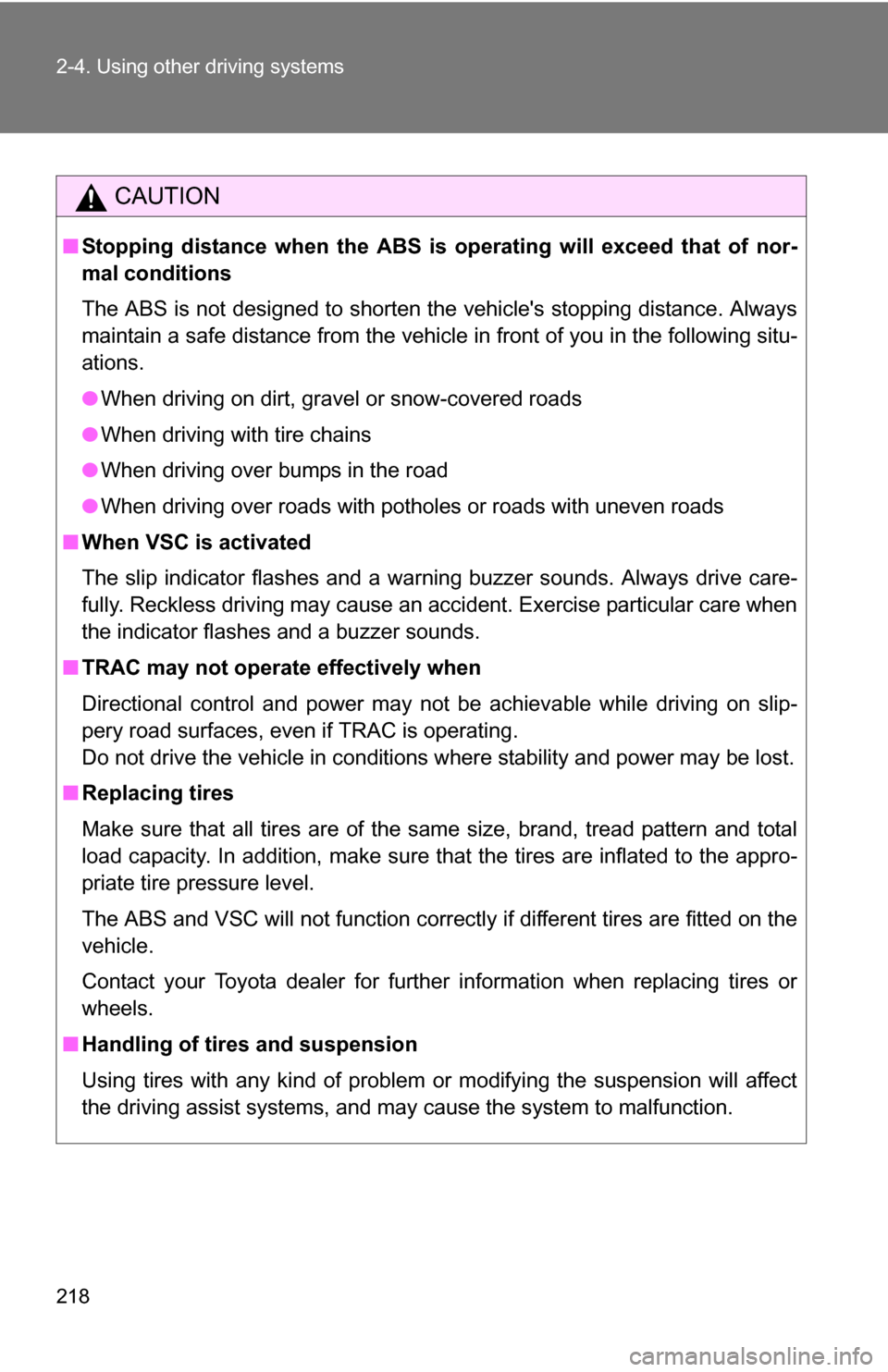
218 2-4. Using other driving systems
CAUTION
■Stopping distance when the ABS is operating will exceed that of nor-
mal conditions
The ABS is not designed to shorten the vehicle's stopping distance. Always
maintain a safe distance from the vehicle in front of you in the following situ-
ations.
● When driving on dirt, gravel or snow-covered roads
● When driving with tire chains
● When driving over bumps in the road
● When driving over roads with pothol es or roads with uneven roads
■ When VSC is activated
The slip indicator flashes and a warning buzzer sounds. Always drive care-
fully. Reckless driving may cause an accident. Exercise particular care when
the indicator flashes and a buzzer sounds.
■ TRAC may not operate effectively when
Directional control and power may not be achievable while driving on slip-
pery road surfaces, even if TRAC is operating.
Do not drive the vehicle in conditions where stability and power may be lost.
■ Replacing tires
Make sure that all tires are of the same size, brand, tread pattern and total
load capacity. In addition, make sure that the tires are inflated to the appro-
priate tire pressure level.
The ABS and VSC will not function correctly if different tires are fitted on the
vehicle.
Contact your Toyota dealer for further information when replacing tires or
wheels.
■ Handling of tires and suspension
Using tires with any kind of problem or modifying the suspension will affect
the driving assist systems, and may cause the system to malfunction.
Page 224 of 596
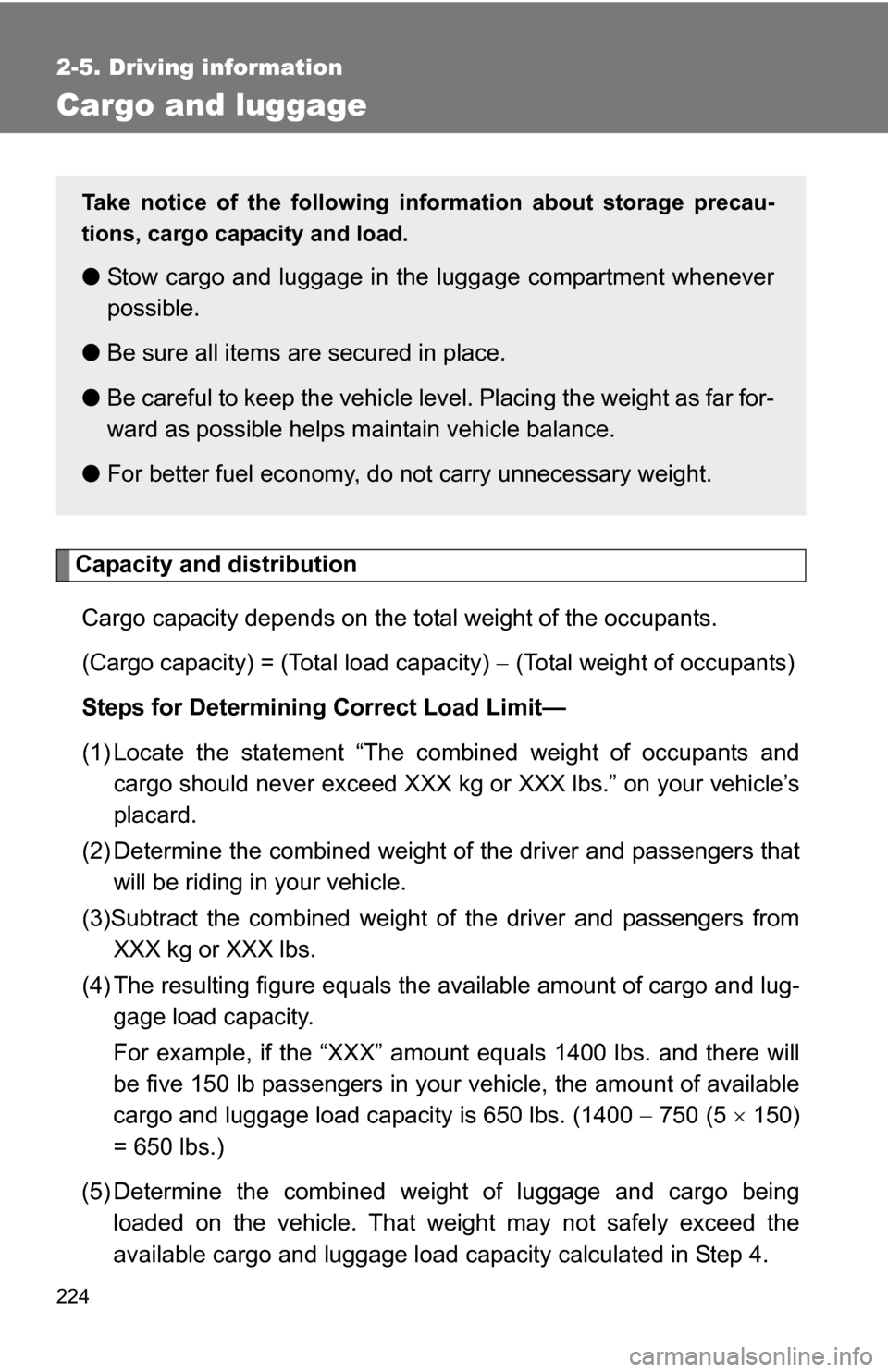
224
2-5. Driving information
Cargo and luggage
Capacity and distributionCargo capacity depends on the total weight of the occupants.
(Cargo capacity) = (Total load capacity) (Total weight of occupants)
Steps for Determining Correct Load Limit—
(1) Locate the statement “The co mbined weight of occupants and
cargo should never exceed XXX kg or XXX lbs.” on your vehicle’s
placard.
(2) Determine the combined weight of the driver and passengers that
will be riding in your vehicle.
(3)Subtract the combined weight of the driver and passengers from XXX kg or XXX lbs.
(4) The resulting figure equals the av ailable amount of cargo and lug-
gage load capacity.
For example, if the “XXX” amount equals 1400 lbs. and there will
be five 150 lb passengers in your vehicle, the amount of available
cargo and luggage load capacity is 650 lbs. (1400 750 (5 150)
= 650 lbs.)
(5) Determine the combined weight of luggage and cargo being loaded on the vehicle. That weight may not safely exceed the
available cargo and luggage load capacity calculated in Step 4.
Take notice of the following information about storage precau-
tions, cargo capacity and load.
●Stow cargo and luggage in the luggage compartment whenever
possible.
● Be sure all items are secured in place.
● Be careful to keep the vehicle level. Placing the weight as far for-
ward as possible helps maintain vehicle balance.
● For better fuel economy, do no t carry unnecessary weight.
Page 225 of 596
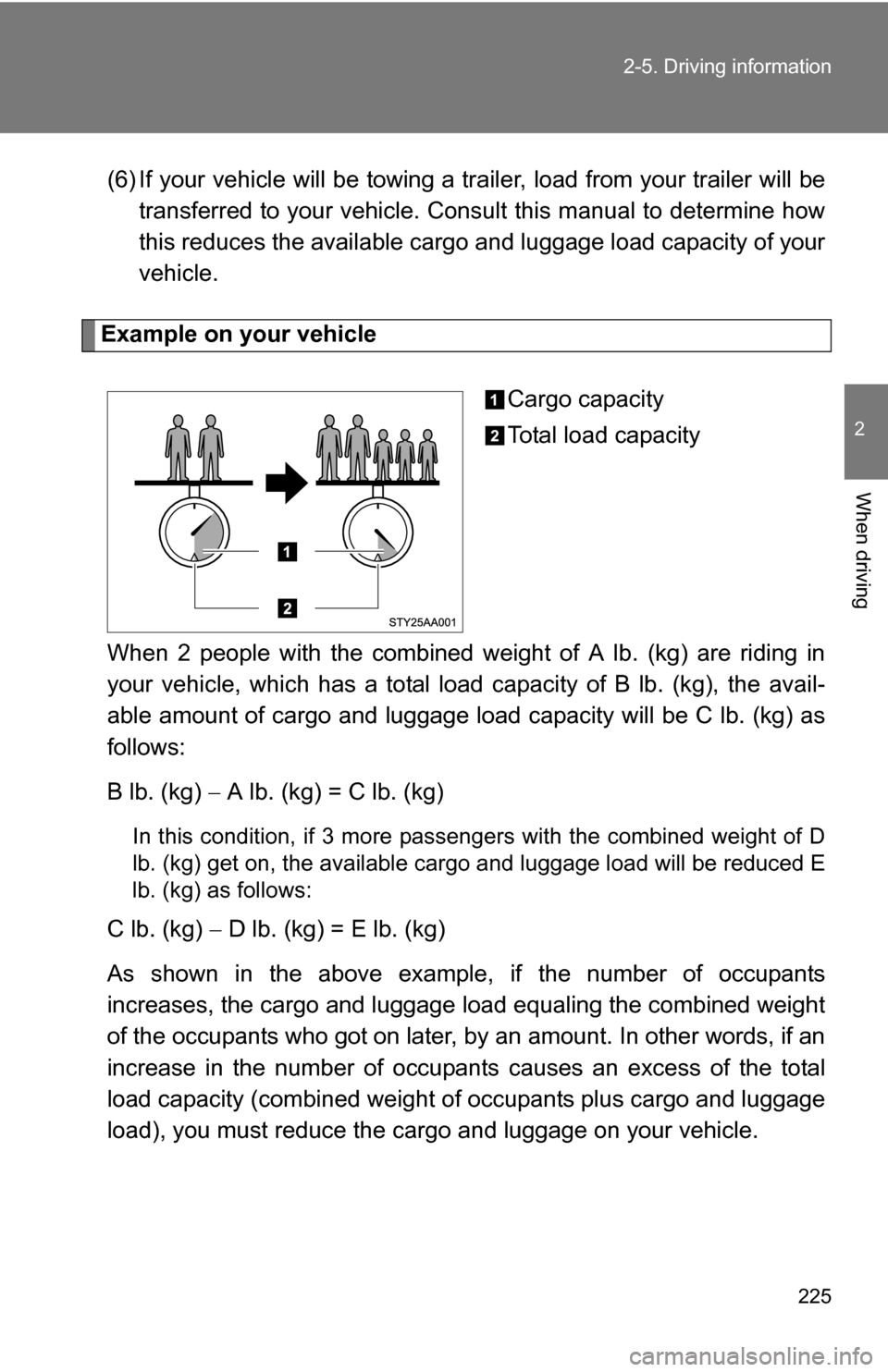
225
2-5. Driving information
2
When driving
(6) If your vehicle will be towing a tr
ailer, load from your trailer will be
transferred to your vehicle. Consult this manual to determine how
this reduces the available cargo and luggage load capacity of your
vehicle.
Example on your vehicle
Cargo capacity
Total load capacity
When 2 people with the combined weight of A lb. (kg) are riding in
your vehicle, which has a total load capacity of B lb. (kg), the avail-
able amount of cargo and luggage load capacity will be C lb. (kg) as
follows:
B lb. (kg) A lb. (kg) = C lb. (kg)
In this condition, if 3 more passengers with the combined weight of D
lb. (kg) get on, the available carg o and luggage load will be reduced E
lb. (kg) as follows:
C lb. (kg) D lb. (kg) = E lb. (kg)
As shown in the above example, if the number of occupants
increases, the cargo and luggage load equaling the combined weight
of the occupants who got on later, by an amount. In other words, if an
increase in the number of occupants causes an excess of the total
load capacity (combined weight of occupants plus cargo and luggage
load), you must reduce the ca rgo and luggage on your vehicle.
Page 226 of 596
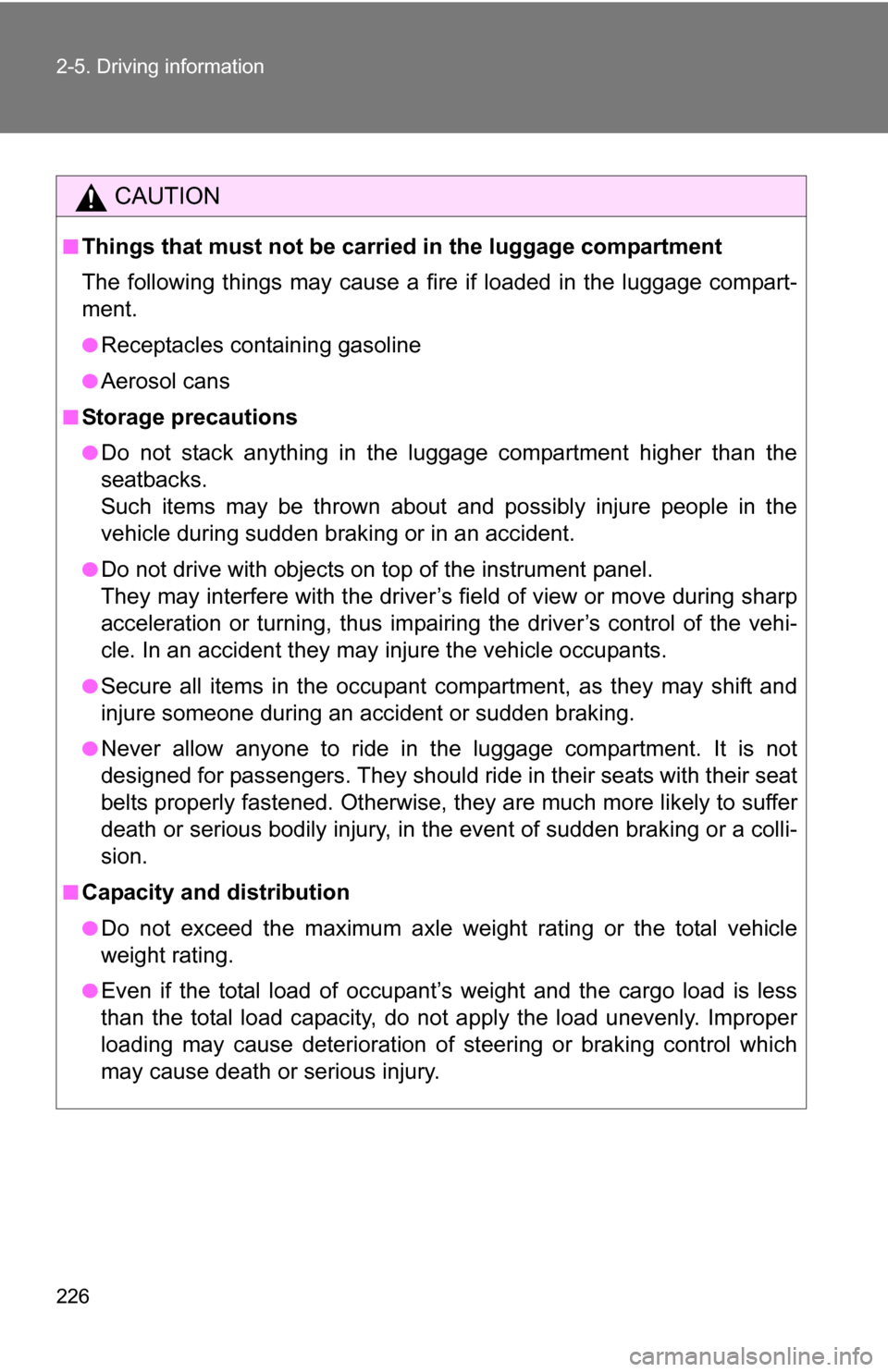
226 2-5. Driving information
CAUTION
■Things that must not be carried in the luggage compartment
The following things may cause a fire if loaded in the luggage compart-
ment.
●Receptacles containing gasoline
●Aerosol cans
■Storage precautions
●Do not stack anything in the luggage compartment higher than the
seatbacks.
Such items may be thrown about and possibly injure people in the
vehicle during sudden braking or in an accident.
●Do not drive with objects on top of the instrument panel.
They may interfere with the driver’s field of view or move during sharp
acceleration or turning, thus impairing the driver’s control of the vehi-
cle. In an accident they may injure the vehicle occupants.
●Secure all items in the occupant compartment, as they may shift and
injure someone during an accident or sudden braking.
●Never allow anyone to ride in the luggage compartment. It is not
designed for passengers. They should ride in their seats with their seat
belts properly fastened. Otherwise, th ey are much more likely to suffer
death or serious bodily injury, in the event of sudden braking or a colli-
sion.
■Capacity and distribution
●Do not exceed the maximum axle weight rating or the total vehicle
weight rating.
●Even if the total load of occupant’s weight and the cargo load is less
than the total load capacity, do not apply the load unevenly. Improper
loading may cause deterioration of steering or braking control which
may cause death or serious injury.
Page 228 of 596
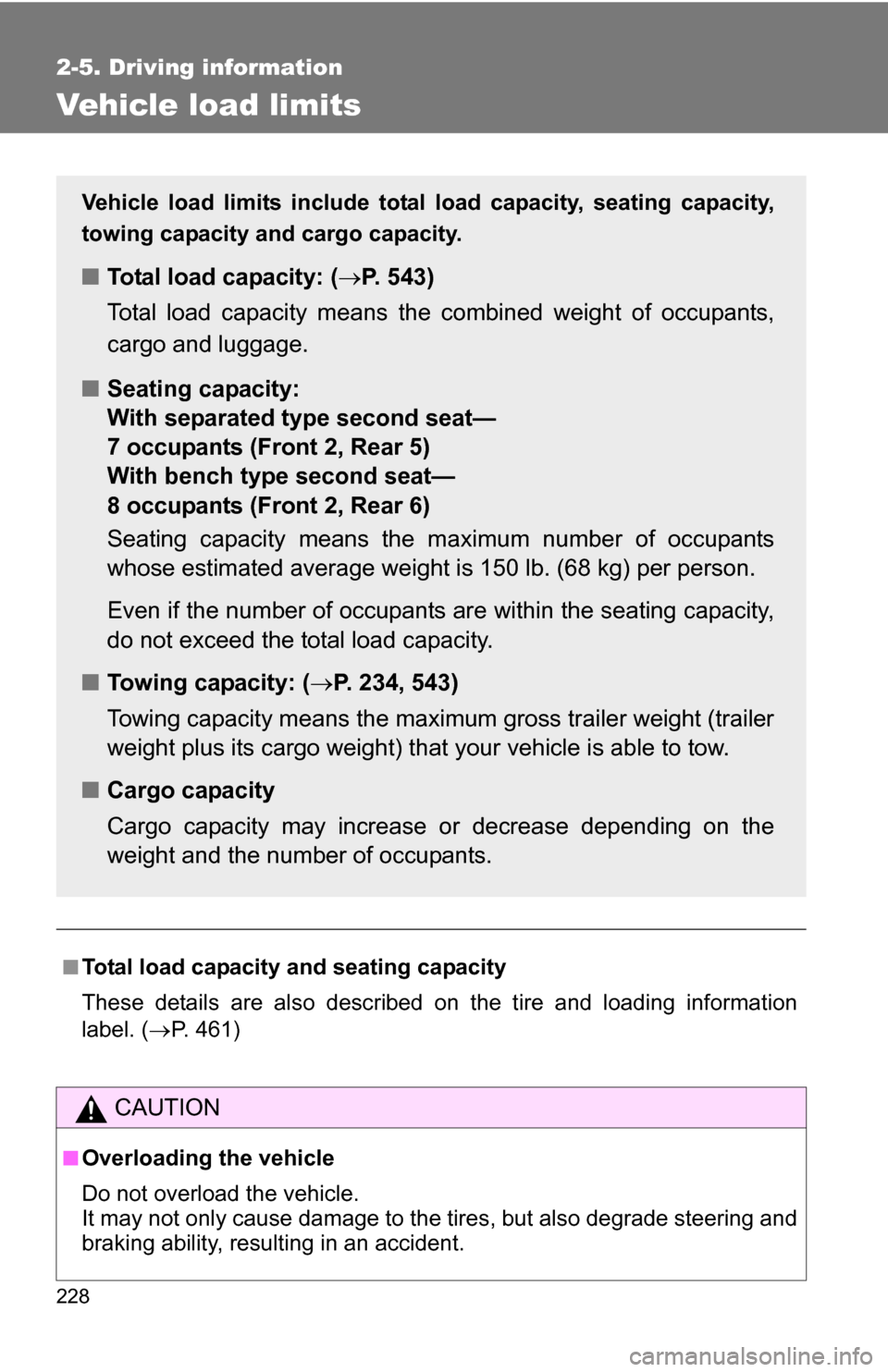
228
2-5. Driving information
Vehicle load limits
■Total load capacity and seating capacity
These details are also described on the tire and loading information
label. (P. 461)
CAUTION
■Overloading the vehicle
Do not overload the vehicle.
It may not only cause damage to the ti res, but also degrade steering and
braking ability, resulting in an accident.
Vehicle load limits include total load capacity, seating capacity,
towing capacity and cargo capacity.
■ Total load capacity: ( P. 543)
Total load capacity means the combined weight of occupants,
cargo and luggage.
■ Seating capacity:
With separated type second seat—
7 occupants (Front 2, Rear 5)
With bench type second seat—
8 occupants (Front 2, Rear 6)
Seating capacity means the ma ximum number of occupants
whose estimated average weight is 150 lb. (68 kg) per person.
Even if the number of occupants are within the seating capacity,
do not exceed the total load capacity.
■ Towing capacity: ( P. 234, 543)
Towing capacity means the maximum gross trailer weight (trailer
weight plus its cargo weight) that your vehicle is able to tow.
■ Cargo capacity
Cargo capacity may increase or decrease depending on the
weight and the number of occupants.
Page 234 of 596
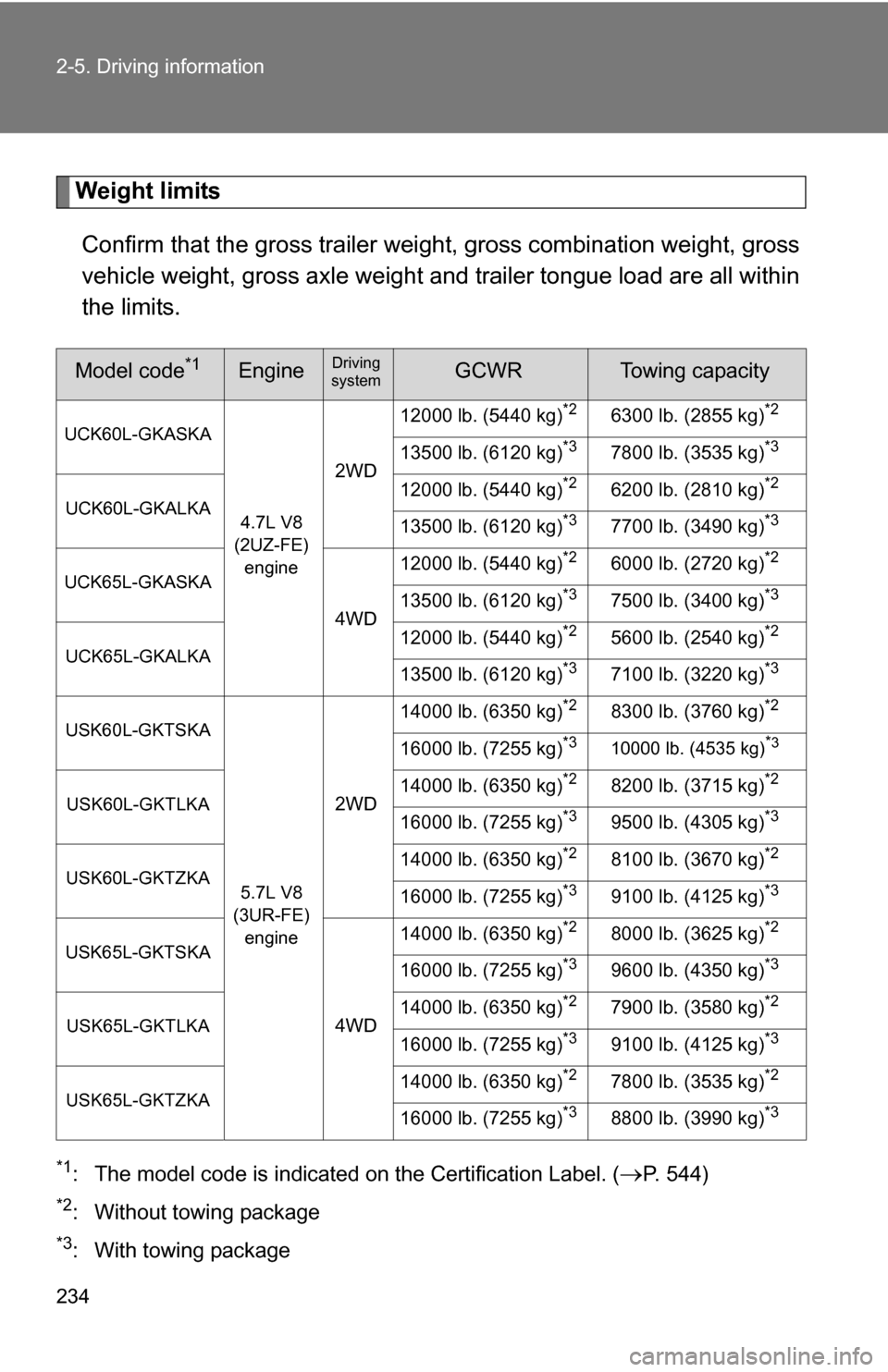
234 2-5. Driving information
Weight limitsConfirm that the gross trailer weight, gross combination weight, gross
vehicle weight, gross axle weight and trailer tongue load are all within
the limits.
*1: The model code is indicated on the Certification Label. (P. 544)
*2: Without towing package
*3: With towing package
Model code*1EngineDriving
systemGCWRTowing capacity
UCK60L-GKASKA
4.7L V8
(2UZ-FE) engine
2WD 12000 lb. (5440 kg)
*26300 lb. (2855 kg)*2
13500 lb. (6120 kg)*37800 lb. (3535 kg)*3
UCK60L-GKALKA12000 lb. (5440 kg)*26200 lb. (2810 kg)*2
13500 lb. (6120 kg)*37700 lb. (3490 kg)*3
UCK65L-GKASKA
4WD12000 lb. (5440 kg)
*26000 lb. (2720 kg)*2
13500 lb. (6120 kg)*37500 lb. (3400 kg)*3
UCK65L-GKALKA12000 lb. (5440 kg)*25600 lb. (2540 kg)*2
13500 lb. (6120 kg)*37100 lb. (3220 kg)*3
USK60L-GKTSKA
5.7L V8
(3UR-FE) engine
2WD 14000 lb. (6350 kg)
*28300 lb. (3760 kg)*2
16000 lb. (7255 kg)*310000 lb. (4535 kg)*3
USK60L-GKTLKA14000 lb. (6350 kg)*28200 lb. (3715 kg)*2
16000 lb. (7255 kg)*39500 lb. (4305 kg)*3
USK60L-GKTZKA14000 lb. (6350 kg)*28100 lb. (3670 kg)*2
16000 lb. (7255 kg)*39100 lb. (4125 kg)*3
USK65L-GKTSKA
4WD14000 lb. (6350 kg)
*28000 lb. (3625 kg)*2
16000 lb. (7255 kg)*39600 lb. (4350 kg)*3
USK65L-GKTLKA14000 lb. (6350 kg)*27900 lb. (3580 kg)*2
16000 lb. (7255 kg)*39100 lb. (4125 kg)*3
USK65L-GKTZKA14000 lb. (6350 kg)*27800 lb. (3535 kg)*2
16000 lb. (7255 kg)*38800 lb. (3990 kg)*3
Page 235 of 596
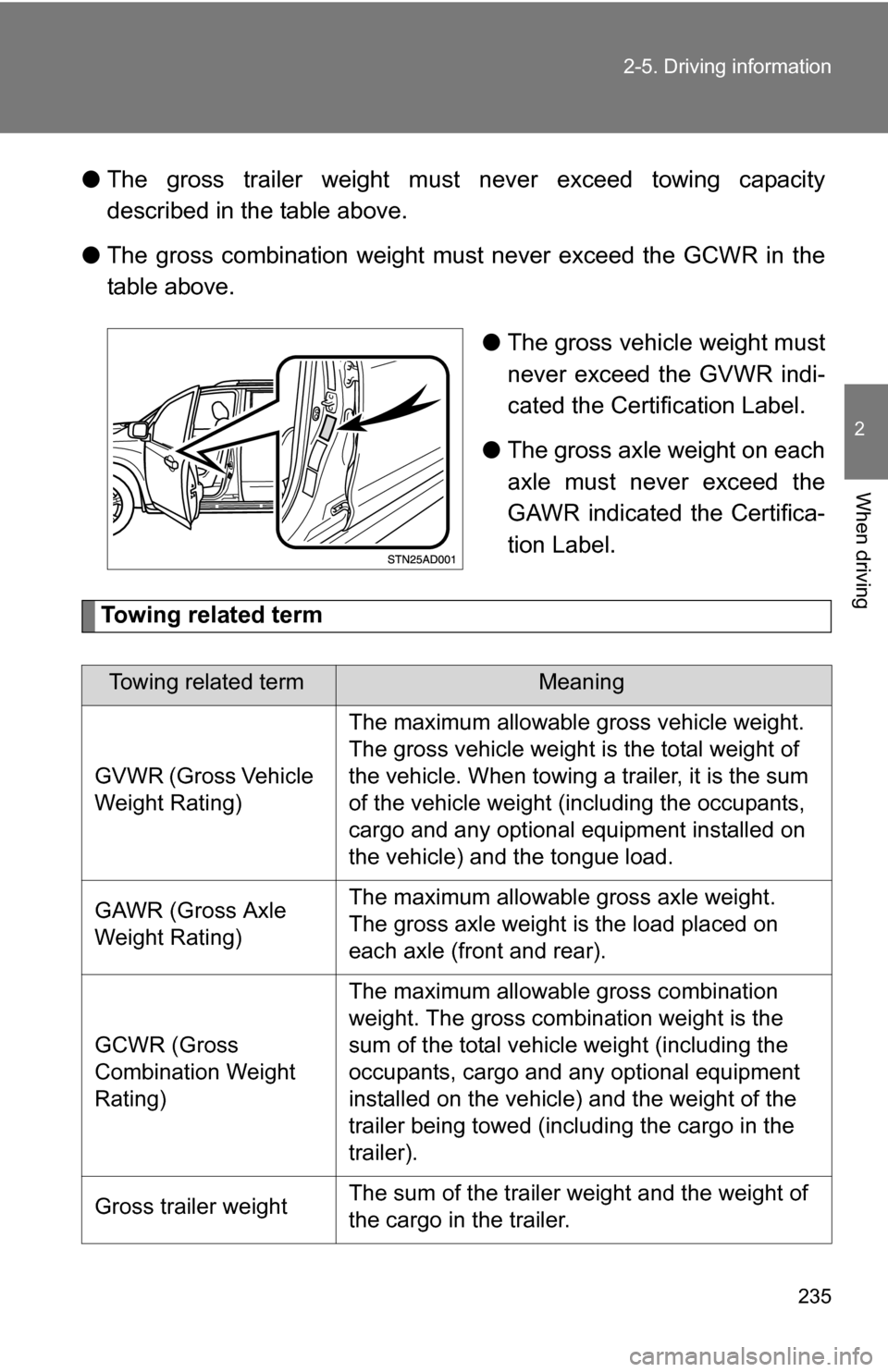
235
2-5. Driving information
2
When driving
●
The gross trailer weight must never exceed towing capacity
described in the table above.
● The gross combination weight must never exceed the GCWR in the
table above.
●The gross vehicle weight must
never exceed the GVWR indi-
cated the Certification Label.
● The gross axle weight on each
axle must never exceed the
GAWR indicated the Certifica-
tion Label.
Towing related term
Towing related termMeaning
GVWR (Gross Vehicle
Weight Rating)
The maximum allowable gross vehicle weight.
The gross vehicle weight is the total weight of
the vehicle. When towing a trailer, it is the sum
of the vehicle weight (including the occupants,
cargo and any optional equipment installed on
the vehicle) and the tongue load.
GAWR (Gross Axle
Weight Rating)The maximum allowable gross axle weight.
The gross axle weight is the load placed on
each axle (front and rear).
GCWR (Gross
Combination Weight
Rating)
The maximum allowabl e gross combination
weight. The gross combination weight is the
sum of the total vehicle weight (including the
occupants, cargo and any optional equipment
installed on the vehicle) and the weight of the
trailer being towed (including the cargo in the
trailer).
Gross trailer weightThe sum of the trailer weight and the weight of
the cargo in the trailer.
Page 236 of 596
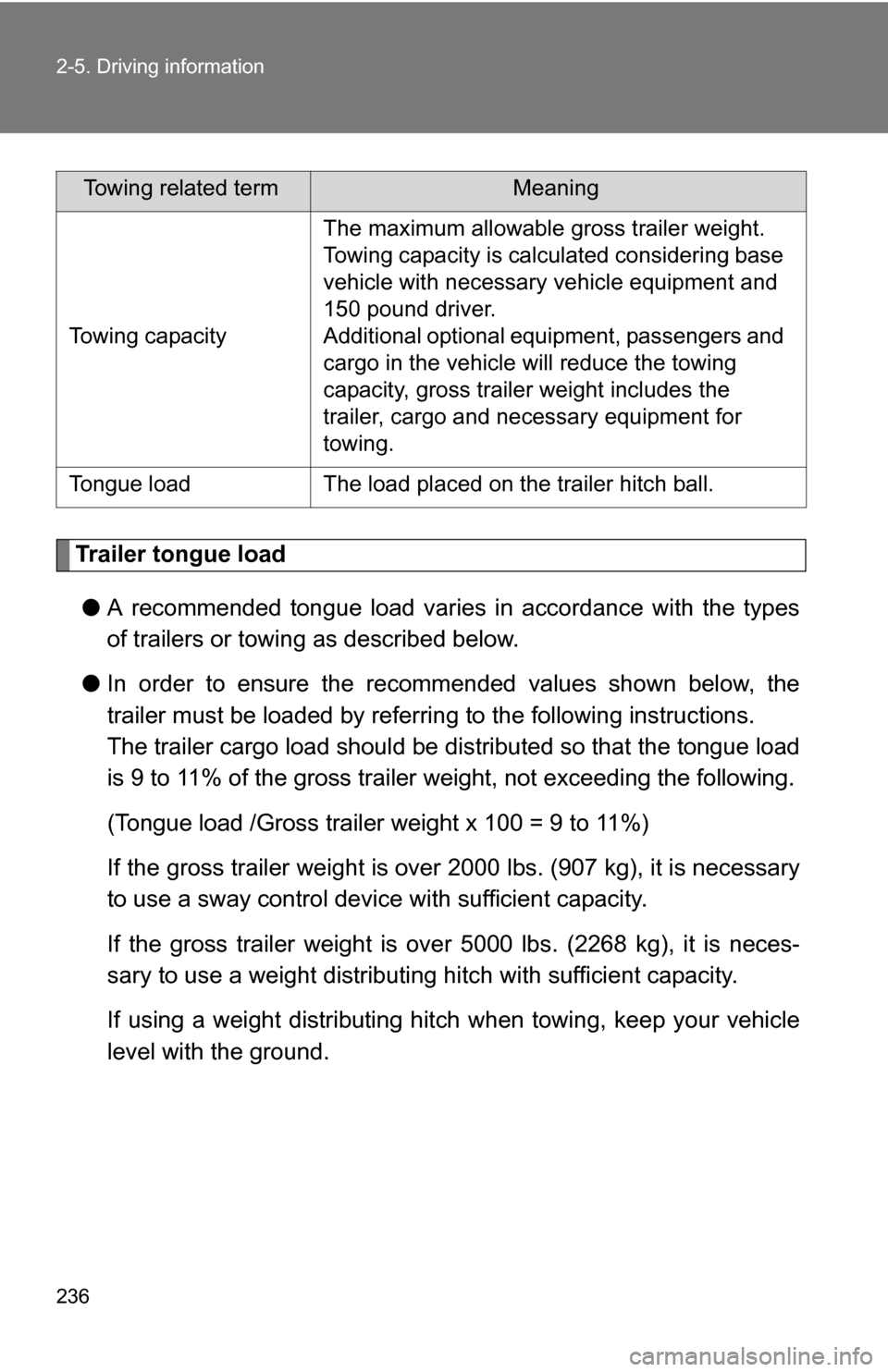
236 2-5. Driving information
Trailer tongue load● A recommended tongue load varies in accordance with the types
of trailers or towing as described below.
● In order to ensure the recommended values shown below, the
trailer must be loaded by referring to the following instructions.
The trailer cargo load should be distributed so that the tongue load
is 9 to 11% of the gross trailer weight, not exceeding the following.
(Tongue load /Gross trailer weight x 100 = 9 to 11%)
If the gross trailer weight is over 2000 lbs. (907 kg), it is necessary
to use a sway control device with sufficient capacity.
If the gross trailer weight is over 5000 lbs. (2268 kg), it is neces-
sary to use a weight distributing hitch with sufficient capacity.
If using a weight distributing hitc h when towing, keep your vehicle
level with the ground.
Towing related termMeaning
Towing capacity
The maximum allowable gross trailer weight.
Towing capacity is calculated considering base
vehicle with necessary vehicle equipment and
150 pound driver.
Additional optional equipment, passengers and
cargo in the vehicle will reduce the towing
capacity, gross trailer weight includes the
trailer, cargo and necessary equipment for
towing.
Tongue loadThe load placed on the trailer hitch ball.
Page 244 of 596
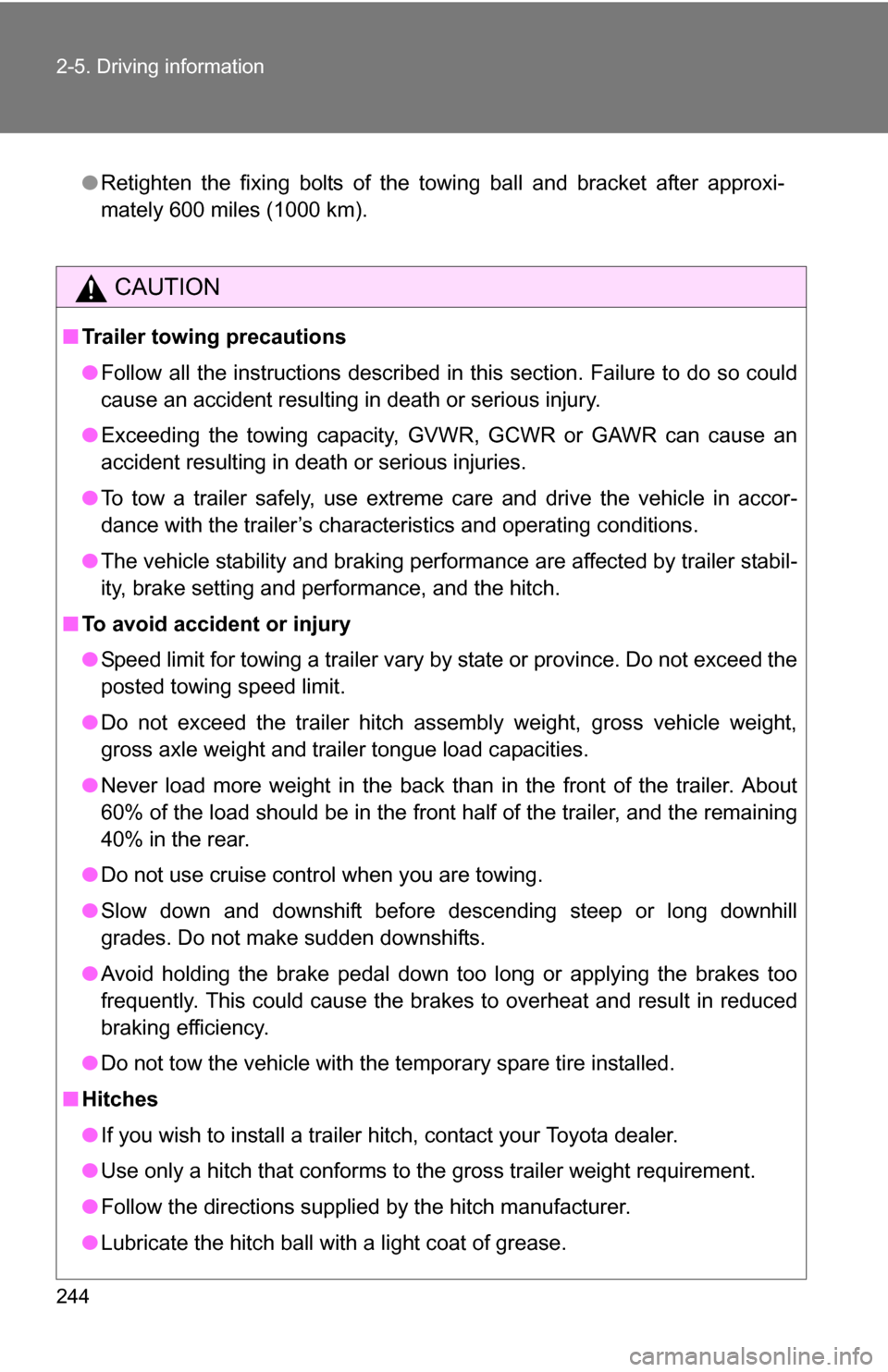
244 2-5. Driving information
●Retighten the fixing bolts of the towing ball and bracket after approxi-
mately 600 miles (1000 km).
CAUTION
■Trailer towing precautions
●Follow all the instructions described in this section. Failure to do so could
cause an accident resulting in death or serious injury.
● Exceeding the towing capacity, GVWR, GCWR or GAWR can cause an
accident resulting in death or serious injuries.
● To tow a trailer safely, use extreme care and drive the vehicle in accor-
dance with the trailer’s characteristics and operating conditions.
● The vehicle stability and braking performance are affected by trailer stabil-
ity, brake setting and performance, and the hitch.
■ To avoid accident or injury
●Speed limit for towing a trailer vary by state or province. Do not exceed the
posted towing speed limit.
● Do not exceed the trailer hitch assembly weight, gross vehicle weight,
gross axle weight and trailer tongue load capacities.
● Never load more weight in the back than in the front of the trailer. About
60% of the load should be in the front half of the trailer, and the remaining
40% in the rear.
● Do not use cruise control when you are towing.
● Slow down and downshift before descending steep or long downhill
grades. Do not make sudden downshifts.
● Avoid holding the brake pedal down too long or applying the brakes too
frequently. This could cause the brakes to overheat and result in reduced
braking efficiency.
● Do not tow the vehicle with the temporary spare tire installed.
■ Hitches
●If you wish to install a trailer hitch, contact your Toyota dealer.
● Use only a hitch that conforms to the gross trailer weight requirement.
● Follow the directions supplied by the hitch manufacturer.
● Lubricate the hitch ball with a light coat of grease.
Page 458 of 596
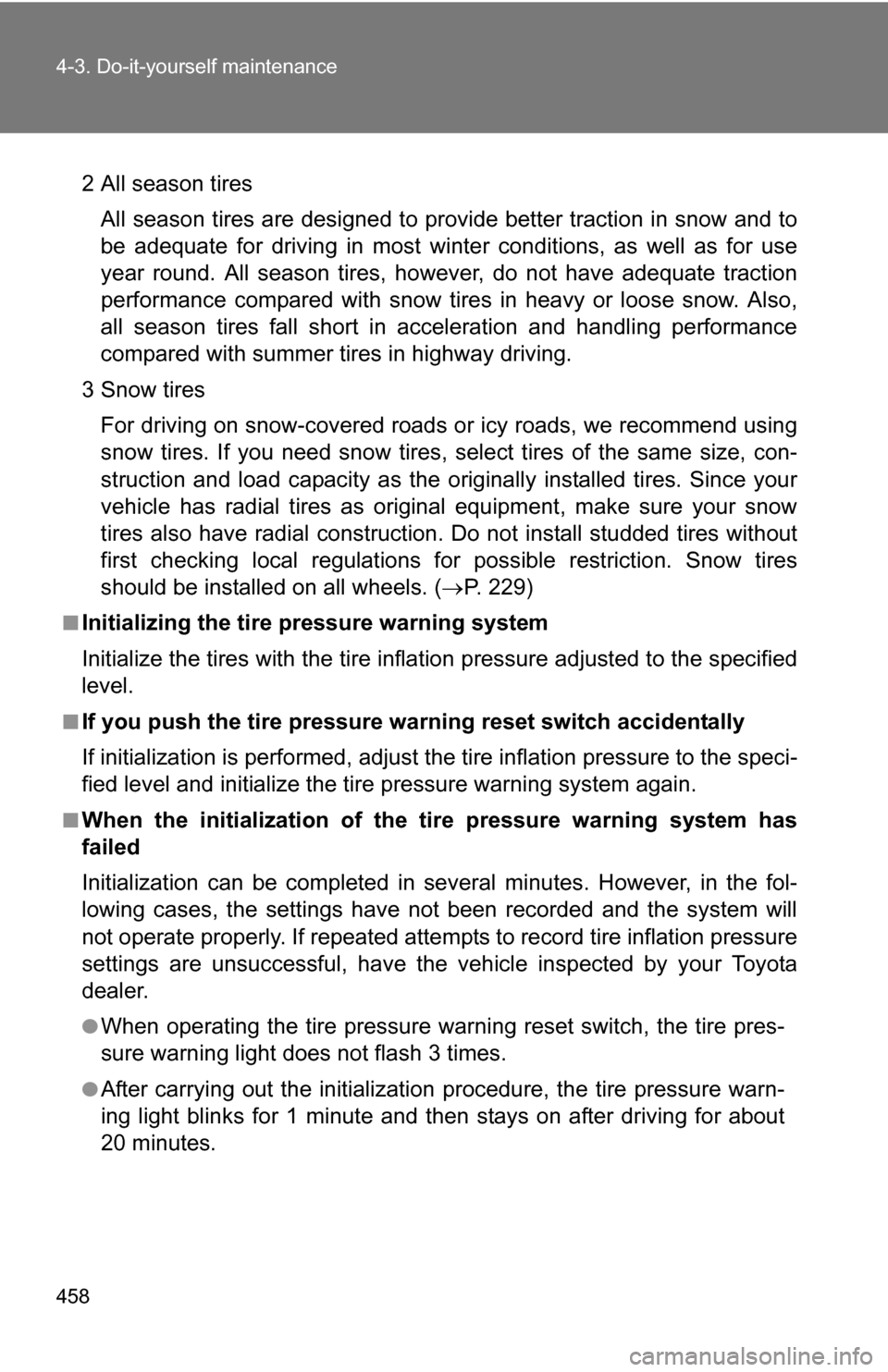
458 4-3. Do-it-yourself maintenance
2 All season tiresAll season tires are designed to provide better traction in snow and to
be adequate for driving in most winter conditions, as well as for use
year round. All season tires, however, do not have adequate traction
performance compared with snow tires in heavy or loose snow. Also,
all season tires fall short in acceleration and handling performance
compared with summer tires in highway driving.
3Snow tires For driving on snow-covered roads or icy roads, we recommend using
snow tires. If you need snow tires, select tires of the same size, con-
struction and load capacity as the or iginally installed tires. Since your
vehicle has radial tires as original equipment, make sure your snow
tires also have radial construction. Do not install studded tires without
first checking local regulations for possible restriction. Snow tires
should be installed on all wheels. ( P. 229)
■Initializing the tire pr essure warning system
Initialize the tires with the tire inflati on pressure adjusted to the specified
level.
■If you push the tire pressure warning reset switch accidentally
If initialization is performed, adjust the tire in flation pressure to the speci-
fied level and initialize the tire pressure warning system again.
■When the initialization of the tire pressure warning system has
failed
Initialization can be completed in se veral minutes. However, in the fol-
lowing cases, the settings have not been recorded and the system will
not operate properly. If repeated attempts to record tire inflation pressure
settings are unsuccessful, have the vehicle inspected by your Toyota
dealer.
●When operating the tire pressure warning reset switch, the tire pres-
sure warning light does not flash 3 times.
●After carrying out the initialization procedure, the tire pressure warn-
ing light blinks for 1 minute and then stays on after driving for about
20 minutes.